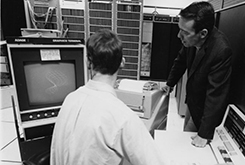Birth of the Internet
September 9, 2019

In 1968, the nation’s top computer scientists and members of the U.S. government gathered inside the Rustler Lodge atop the Alta Ski Resort in Salt Lake County, Utah. They were about to change the world.
It was during that meeting this group talked about the novel idea of connecting computers together into the world’s first far-reaching communications network.

An early sketch describing the first four nodes of the ARPANET
A year later, four institutions — UCLA, the Stanford Research Institute, University of California at Santa Barbara and the University of Utah — became the first “nodes” to that network, then known as ARPANET, the Advanced Research Projects Agency Network.
It was the precursor to what we now call the internet.
To celebrate the 50th anniversary of this revolutionary milestone in communications, the University of Utah’s School of Computing is hosting a celebration to commemorate the U’s involvement in the birth of the internet and to look forward at the future technological advancements in store for the university and the state of Utah.
The event will be held Monday, Oct. 7, beginning at 5:30 p.m. at the Robert H. and Katharine B. Garff Building, 1731 E. Campus Center Drive, in the Kahlert Hall and auditorium. Register Here
Scheduled speakers include Utah Lt. Gov. Spencer J. Cox; Damien Patton, CEO of Park City-based social media company Banjo; and University of Utah School of Computing associate professor Kobus Van der Merwe, who leads the POWDER wireless communications testbed recently launched in Salt Lake City. Opening remarks will be given by University of Utah President Ruth V. Watkins, SVP of Academic Affairs Daniel A. Reed and College of Engineering Dean Richard B. Brown.
A New Network
In the 1960s, the Department of Defense’s Advanced Research Projects Agency (ARPA) and its Information Processing Techniques Office (IPTO) were funding computer projects and looking for a way to network computers together. IPTO director Robert Taylor and program manager Larry Roberts proceeded with a new idea of packet-switching as a form of transferring data from one computer to another. They set out looking for the top universities in the field to research it.
Meanwhile, David Evans, who was the U’s first chair of its computer science department (now known as the School of Computing), had been building the department’s reputation as an international center for computer science research. He brought in the finest faculty and researchers in computer science, including graphics legend Ivan Sutherland (who also led the IPTO at one time), and graduate students John Warnock (who later founded Adobe) and Steve Carr, to name just a few. It was partly because of the U’s growing reputation for graphics that it became one of the first four nodes for ARPANET.
The architecture for the ARPANET utilized an Internet message processor (IMP) at each of the four institutions. On Oct. 29, 1969 — when UCLA and Stanford were the only ones connected at the time — UCLA student Charles Kline was supposed to send the first message over the network with the word “login.” He got the “l” and the “o” through successfully before the computers crashed. It was half a message, but they were the first letters to be transmitted long distance between two networked computers.
The U was added as the fourth node in December 1969 using a DEC PDP-10 computer and the TENEX operating system. By 1981, there were 213 nodes connected to ARPANET. In 1990, ARPNET was retired, and most university computers migrated to a newer network. But those first four nodes will be remembered for being the launching point for a new technological revolution. The internet today is now the foundation for nearly all electronic communications in the world, from websites to email.
“The University of Utah College of Engineering is pleased to have as part of its legacy the role it played in the establishment of the internet, which has had a profound effect on every aspect of modern life,” said U College of Engineering Dean Richard B. Brown. “It is not a stretch to say that the ARPANET led to our ability to access information instantly, to our ability to communicate for free, and to the tech boom in Utah’s economy known as Silicon Slopes.”
